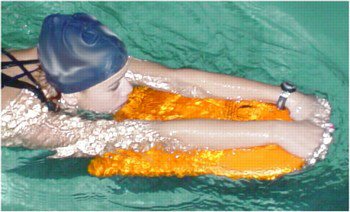1/13/04 Don’t Go To the Board: Treating Shoulder Soreness
Differently
There is a widespread misconception among coaches and swimmers thinking about
treating shoulder injuries. During workout if you begin to feel pain or
soreness in your shoulder and you switch to kicking with a traditional
kickboard, using a traditional position, you may actually be making the problem
worse.
The traditional position -- with your hands holding the tip of the board, your
elbows resting on the surface of the board and your head up, eyes looking
forward -- increases the pressure on your rotator cuff. The main movement that
causes pain in the shoulder during freestyle is the top catch of the stroke.
Kicking with a board can cause your shoulder to feel prolonged pressure similar
to what you feel during the catch.

|
This position can add pressure to the impingement of
the tendons of the rotator cuff muscles (Supraspinatus, Infraspinatus, Teres
Minor, and Subcapularis muscle tendons). These muscles help hold the
ball-and-socket joint of the shoulder tightly in place. These four muscles all
cross through a relatively small space. When these soft tissues become
inflamed, the space tightens and impingement occurs, resulting in a
“pinching feeling.”
|
There are several ways to avoid pain in your shoulder and continue to work out
without causing pain. And you can add variety to the workout design at the same
time. These include:
-
Kicking with a smaller kickboard, or even a pull buoy, so that you are lower in
the water and the pressure on your rotator cuff is not as intense.
-
Kicking without a kickboard, using a drill such as the extension kick, which
will promote good body position and avoid shoulder pressure.
-
Continuing to swim, but with fins. While you are swimming, use your legs -- not
your arms -- for most of your propulsion. Let your arms go through the swimming
motion without pulling or catching the water. This will allow you to keep your
shoulder loose and keep working on your body rotation.




